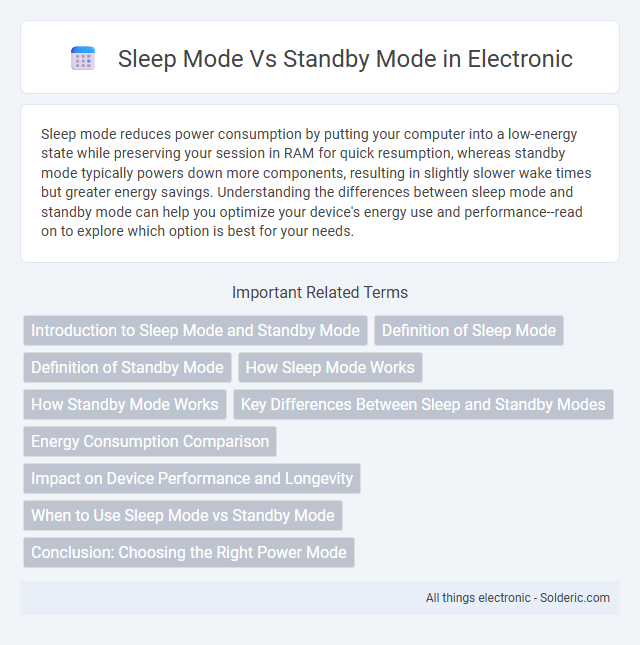Sleep mode reduces power consumption by putting your computer into a low-energy state while preserving your session in RAM for quick resumption, whereas standby mode typically powers down more components, resulting in slightly slower wake times but greater energy savings. Understanding the differences between sleep mode and standby mode can help you optimize your device's energy use and performance--read on to explore which option is best for your needs.
Comparison Table
| Feature | Sleep Mode | Standby Mode |
|---|---|---|
| Power Consumption | Low power, maintains RAM activity | Minimal power, most components off |
| System State | System state saved in RAM | System largely off, some components remain active |
| Wake-up Time | Fast (seconds) | Slower than Sleep mode (seconds to minutes) |
| Use Case | Short breaks, quick resume | Longer inactivity, power saving |
| Data Retention | Maintains session data in RAM | Typically no data retained, device nearly off |
| Example Devices | Computers, smartphones | TVs, remote devices |
Introduction to Sleep Mode and Standby Mode
Sleep mode reduces power consumption by saving your current session to RAM while maintaining minimal energy use, allowing for quick resume times. Standby mode typically powers down most components except essential hardware to support a lower power state but may take longer to wake up. Understanding these modes helps optimize your device's energy efficiency and responsiveness based on usage needs.
Definition of Sleep Mode
Sleep mode is a low-power state that temporarily pauses computer operations while preserving the current session in RAM, enabling quick resumption of work without a full reboot. It significantly reduces energy consumption compared to normal operation by disabling non-essential components while maintaining power to memory. This mode is ideal for short breaks, providing a balance between energy efficiency and usability.
Definition of Standby Mode
Standby mode is a low power state where your device remains partially powered to quickly resume full operation without a full reboot. This mode keeps essential components like memory active while shutting down less critical systems, resulting in minimal energy consumption. Standby is ideal for maintaining open applications and data without complete shutdown, offering a faster wake-up time compared to sleep mode.
How Sleep Mode Works
Sleep mode reduces power consumption by putting the computer into a low-energy state while preserving the current session in RAM. The CPU and display are powered down, but the memory remains active, allowing for quick resumption of work. This mode balances energy efficiency with fast wake-up times, unlike standby which may cut power to RAM and take longer to reload data.
How Standby Mode Works
Standby mode reduces power consumption by keeping your device in a low-energy state while maintaining memory and essential functions to allow quick resumption. It powers down non-essential components but keeps the RAM active, preserving your open files and programs. This enables faster wake times compared to a full shutdown, making it an energy-efficient choice for short breaks.
Key Differences Between Sleep and Standby Modes
Sleep mode saves your current session to RAM, allowing rapid wake-up with minimal power use, while standby mode typically reduces power further by shutting down most system components but may require a longer restart. Sleep mode maintains active memory states for quick access, whereas standby mode often suspends activity, cutting off power to non-essential parts to conserve energy. Understanding these differences helps optimize your device's power management and wake-up speed according to your needs.
Energy Consumption Comparison
Sleep mode consumes significantly less energy than standby mode by powering down non-essential components while maintaining RAM activity for quick resume. Standby mode reduces power by turning off the display and hard drives but still draws more energy due to keeping several circuits active. For optimal energy savings and extended battery life, choosing sleep mode can minimize your device's power consumption without compromising immediate availability.
Impact on Device Performance and Longevity
Sleep mode reduces power consumption by pausing active processes while maintaining memory state, allowing quick resumption without significant wear on hardware components. Standby mode lowers power use more aggressively by shutting down most system functions, which can extend device longevity by minimizing heat generation and component stress. Choosing between modes impacts performance recovery speed and device lifespan, with Sleep mode favoring responsiveness and Standby mode prioritizing hardware preservation.
When to Use Sleep Mode vs Standby Mode
Sleep mode is ideal for short breaks when you want to quickly resume work, as it saves power while keeping your session active in RAM. Standby mode suits longer inactivity periods, conserving more energy by reducing power to essential components but taking slightly longer to wake up. Choosing between the two depends on balancing energy savings with the need for rapid access to your device.
Conclusion: Choosing the Right Power Mode
Sleep mode conserves more power than standby mode by shutting down non-essential systems while keeping RAM active for quick resume, making it ideal for short breaks. Standby mode maintains more system functions in a low-power state, allowing faster wake times but consuming slightly more energy. Selecting between these modes depends on balancing energy savings with the required wake-up speed and duration of inactivity.
Sleep mode vs Standby mode Infographic

 solderic.com
solderic.com